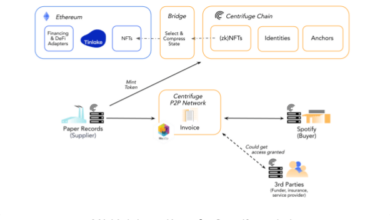What is Proof of Authority?
The Proof-Of-Authority (PoA) is a consensus method that gives a small and designated number of blockchain actors the power to validate transactions or interactions with the network and to update its more or less distributed registry.
It works as follow: according to the chosen scheme, one or more validating machines are responsible for generating each new block of transactions that will be included in the Blockchain.
The new block can be accepted directly without verification, or by unanimous vote of the block generators, or simply by a majority, depending on the configuration chosen for the Blockchain.
”Proof of Authority works as follow: one or more validating machines are responsible for generating each new block of transactions that will be included in the Blockchain”
Proof-of-Authority, low energy consumption but limited number of actors
Unlike the Proof-of-Work mechanism, commonly referred to as “mining”, there is no technical competition between validators here. This consensus mechanism requires almost no computing power, and therefore almost no electricity for its operation.
Since the PoA requires only a limited number of actors, the network can afford to update the blockchain more frequently by reducing the time between each block (Blocktime) and process more transactions (Blocksize) for processing fees close to zero (Transaction fees).
”Proof of Authority requires almost no computing power, and therefore almost no electricity for its operation”
A blockchain that rests on the PoA can do without using a native asset such as Bitcoin or Ether. Moreover, being a validating node does not immobilise any particular capital as in the case of Proof-Of-Stake for example.
We can see that PoA has a certain number of advantages, mainly in terms of cost and scalability, but has a major weakness: a strong centralisation in the hands of a small number of actors.
What usecases for the Proof-of-Authority?
Proof-of-Authority is often favoured by private or consortium blockchains: players in the banking sector, such as JP Morgan with the JPMCoin, use this technology to facilitate the audit of their funds movements, mainly for accounting purposes, with reduced costs.
”Proof-of-Authority is often favoured by private or consortium blockchains”
While it is easily imaginable that no bank will trust JPMCoin for its own funds and prefer to develop an internal solution, it will require a clearing network to link these internal tools and a registry that coordinates all these incompatible solutions.
Using a public blockchain such as Bitcoin, Ethereum or, as some would like Ripple, seems inconceivable given the state of the market and the refractory mentalities of the banking sector. To bring together actors who do not naturally trust each other, a consortium blockchain based on Proof-Of-Authority remains the most credible solution.
Is the Proof-of-Authority censorship resistant?
The validating nodes of a PoA blockchain have full power to decide on new blocks. This means, for example, that they have the possibility to stop specific transactions, which can generate conflicts of interest and even compromise the security of the network. In the context where these nodes are controlled by actors who both do not trust each other and have sometimes conflicts of interests, the permanent control and monitoring of the validity of the operations ensures the stability of the system.
If, for example, the BNP-Paribas validator node wished to add one million euros to its balance without any particular justification, then the nodes under the control of other actors have the possibility to reject any block containing this transaction.
Each block validator is therefore encouraged to fulfil its role in an “honest” way because of the constant monitoring of the other actors. For similar reasons, each validator closely monitors the actions of the other validators.
The example of the banking sector has not been chosen at random: it is an industry involving a small number of actors, very easily identifiable and who do not naturally wish to cooperate but benefit from doing so.
In this essentially centralised industry, these actors operating within a strict contractual and legal framework have a lot to lose in the event of malicious acts. The Proof-Of-Authority meets specific needs within this defined framework, and this solution appears to be an evolution towards efficiency without requiring a revolution in usage or a paradigm shift.
A solution not necessarily replicable
For a cryptocurrency whose actors are essentially decentralised, difficult to identify, and with whom it is not possible to create contractual relationships, Proof of Authority is a very bad solution. How to choose the validating nodes? How to manage this “governance” or consider whether an act is malicious or not?
For limited amounts, in a context where security is less important, or simply for some centralised uses, a secondary network based on the Proof-of-Authority is possible.
This is referred to as sidechains or complementary blockchains, intended to manage many “small” transactions regularly recorded “in batch” on the main blockchain. On Ethereum, this is the role of POA network, a sidechain based on the Proof-of-Authority.
A blockchain based on the the Proof-Of-Authority is therefore a centralised solution, but efficient and using less power. In some industries, this tool will probably become necessary sooner rather than later thanks to its efficiency, audit and coordination even in a situation where trust between actors is difficult to establish.
In a bigger picture, the more robust and decentralised mechanisms, mainly Proof-Of-Work, still seem difficult to replace. PoA will remain a useful tool to consider until public blockchains improve their performance and scalability.
Buy Bitcoin and other cryptocurrencies
[su_siblings depth=”1″ class=””]





